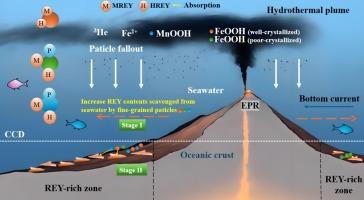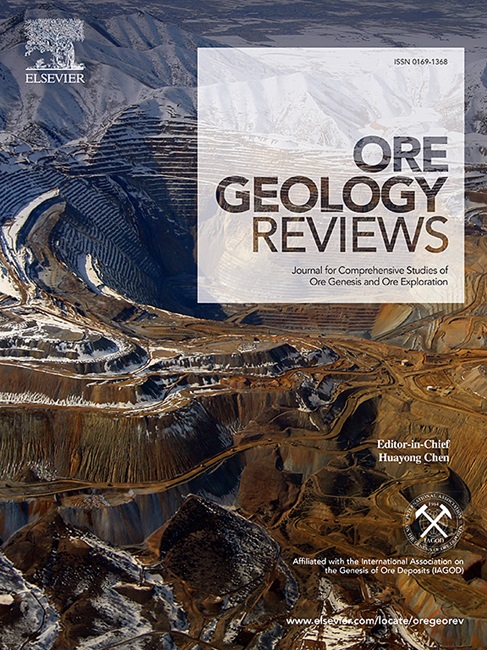Transfer of rare earth elements from clay-sized fraction to phosphate in East South Pacific Ocean: Implication for REY-rich sediment related to hydrothermal influence
IF 3.2
2区 地球科学
Q1 GEOLOGY
引用次数: 0
Abstract
Pelagic sediment enriched in critical metals (e.g. rare earth elements and yttrium, REY) has attracted much attention in recent years. Extensive research has focused on identifying the specific host mineral of REY in bulk pelagic sediment, however, research on clay-sized fraction of REY-rich sediment has not been fully understood yet. In this study, we aimed to investigate the host phase and migration mechanism of REY in clay-sized fractions from two cores, GC23 and GC17, located on the western and eastern sides of the East Pacific Rise (EPR), respectively. To the best of our knowledge, this is the first comprehensive investigation of the clay-sized fraction of REY-rich sediment associated with hydrothermal activity. Results show that GC23 contains negligible clay minerals but well-crystallized Fe oxyhydroxides, while GC17 is rich in smectite and poor-crystallized Fe oxyhydroxides. REY are predominantly hosted in poorly crystallized Fe-Mn oxyhydroxides, with some phosphorus selectively scavenged by Fe oxyhydroxides from seawater. In addition, fluorapatite nanocrystals were first observed within the matrix of Fe oxyhydroxides using transmission electron microscopy (TEM), indicating the formation of fluorapatite. The post-Archean average shale (PAAS)-normalized REY patterns show similar seawater-like patterns in both the clay-sized and silt-sized fraction. The clay-sized fractions primarily derived from hydrothermal plumes plays an important role in scavenging REY from ambient seawater. This study represents a significant step towards understanding the formation of REY-rich sediment related to hydrothermal activity. A two-stage mineralization process is proposed for the formation of REY-rich sediment near the EPR fields. Firstly, REY are initially scavenged by hydrothermal Fe-Mn oxyhydroxide particles from seawater during their lateral dispersion with hydrothermal plumes under low sedimentation rate until they are buried by newly formed precipitates. With the process of early diagenesis, poor crystallized Fe oxyhydroxides will be experienced recrystallization. Subsequently, REY would be released into porewater with the process of recrystallization due to their tendency to remain in a poorly crystallized phase. Ultimately, they are captured by biogenic apatite and/or fluorapatite. The case study indicates that REY-rich sediments may primarily formed within the dispersion area of hydrothermal plumes. Simultaneously, the necessity of slow sedimentation rates, greater water depth, and deep currents all accountable for the formation of REY-rich layers.

南太平洋东部稀土元素从粘土颗粒向磷酸盐的转移:热液影响对富含稀土元素沉积物的影响
富含关键金属(如稀土元素和钇,REY)的远洋沉积物近年来备受关注。大量研究集中于确定大体积远洋沉积物中 REY 的特定宿主矿物,但对富含 REY 的沉积物中粘土大小部分的研究尚未完全了解。本研究旨在研究分别位于东太平洋隆起(EPR)西侧和东侧的两个岩心 GC23 和 GC17 中粘土大小组分中 REY 的宿主相和迁移机制。据我们所知,这是对与热液活动相关的富含 REY 的沉积物中粘土大小部分的首次全面调查。结果表明,GC23 含有可忽略不计的粘土矿物,但含有结晶良好的铁氧氢氧化物,而 GC17 则富含直闪石和结晶不良的铁氧氢氧化物。REY 主要寄存在结晶度较差的铁锰氧氢氧化物中,部分磷被海水中的铁氧氢氧化物选择性地清除。此外,利用透射电子显微镜(TEM)首次在铁氧氢氧化物基质中观察到了氟磷灰石纳米晶体,表明氟磷灰石的形成。后雅典平均页岩(PAAS)归一化 REY 模式在粘土大小部分和粉砂大小部分都显示出类似海水的模式。主要来自热液羽流的粘土大小馏分在从环境海水中清除 REY 方面发挥了重要作用。这项研究标志着在了解与热液活动有关的富含 REY 的沉积物的形成方面迈出了重要一步。研究提出了 EPR 磁场附近富含 REY 沉积物形成的两阶段矿化过程。首先,REY 在低沉积速率下随热液羽流横向扩散过程中,最初被海水中的热液氧氢氧化铁锰颗粒清除,直至被新形成的沉淀物掩埋。随着早期成岩过程的进行,结晶不良的铁氧氢氧化物将经历再结晶过程。随后,REY 会随着再结晶过程释放到孔隙水中,因为它们倾向于停留在低结晶阶段。最终,它们被生物成因磷灰石和/或氟磷灰石捕获。案例研究表明,富含 REY 的沉积物可能主要形成于热液羽流的扩散区域。同时,缓慢的沉积速率、较大的水深和深层水流都是形成富含 REY 的沉积层的必要条件。
本文章由计算机程序翻译,如有差异,请以英文原文为准。
求助全文
约1分钟内获得全文
求助全文
来源期刊

Ore Geology Reviews
地学-地质学
CiteScore
6.50
自引率
27.30%
发文量
546
审稿时长
22.9 weeks
期刊介绍:
Ore Geology Reviews aims to familiarize all earth scientists with recent advances in a number of interconnected disciplines related to the study of, and search for, ore deposits. The reviews range from brief to longer contributions, but the journal preferentially publishes manuscripts that fill the niche between the commonly shorter journal articles and the comprehensive book coverages, and thus has a special appeal to many authors and readers.
 求助内容:
求助内容: 应助结果提醒方式:
应助结果提醒方式:


